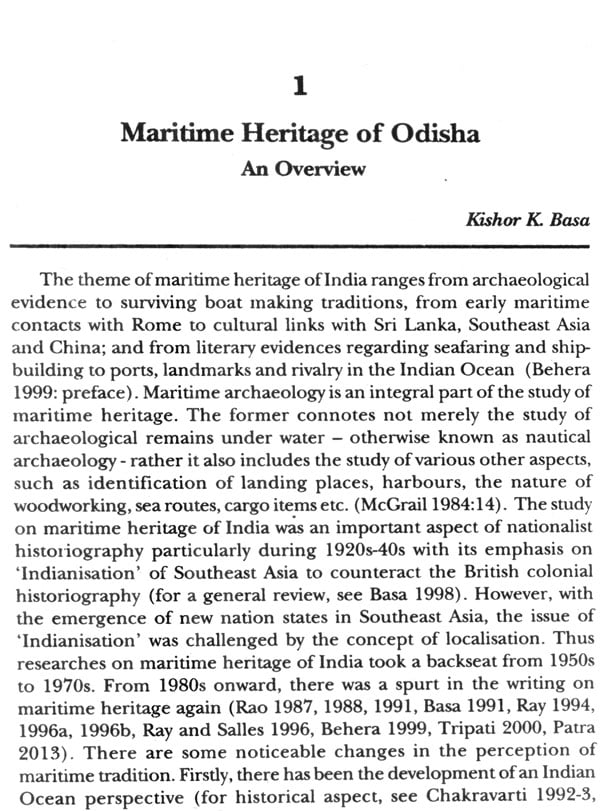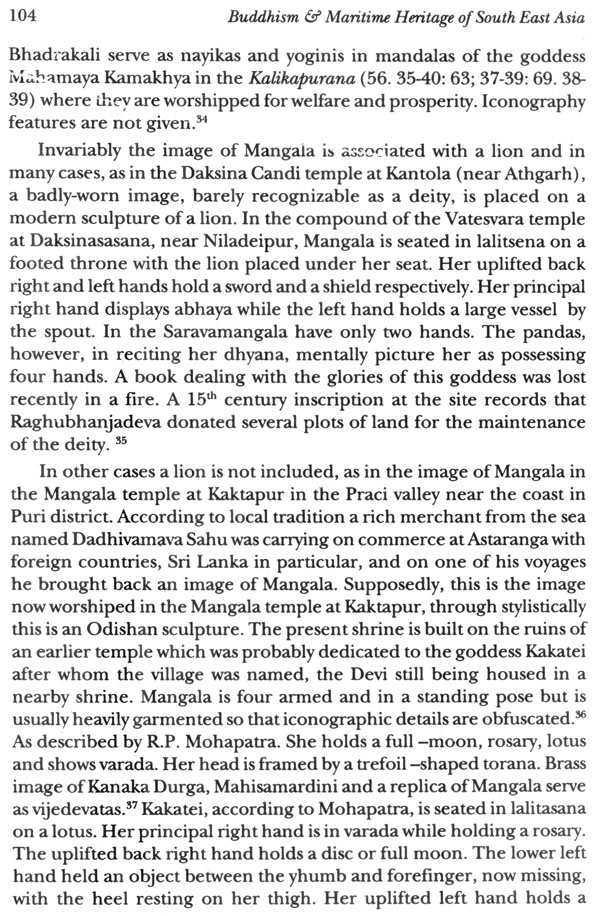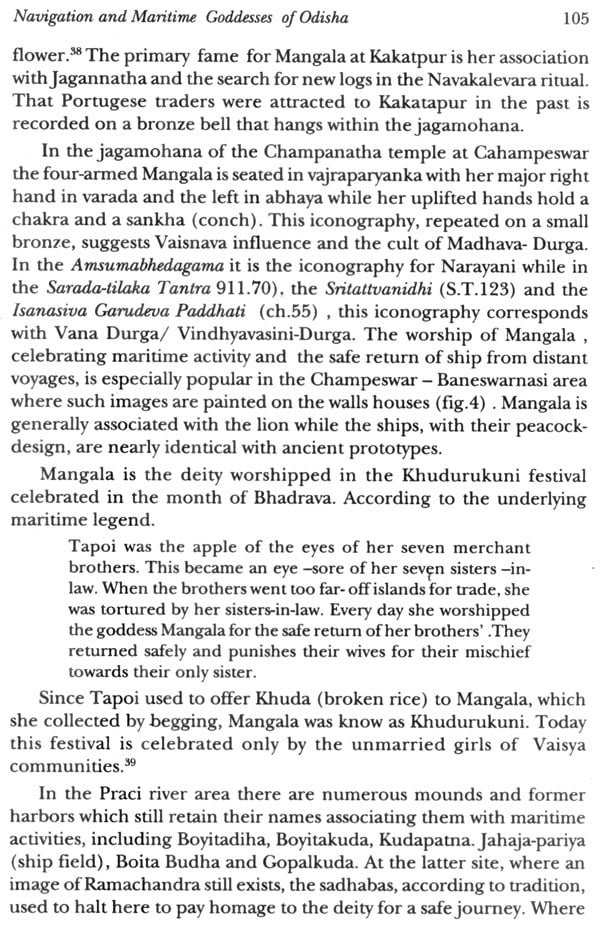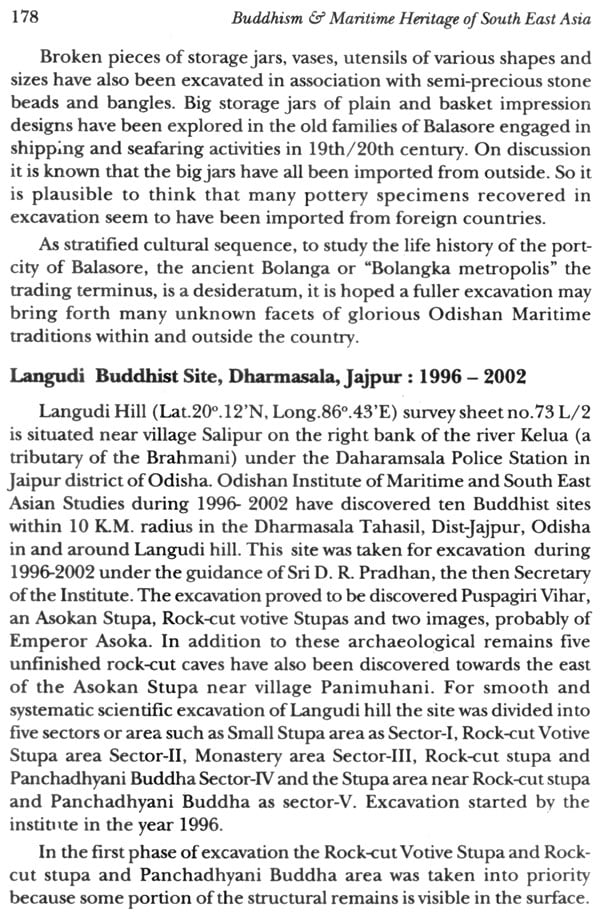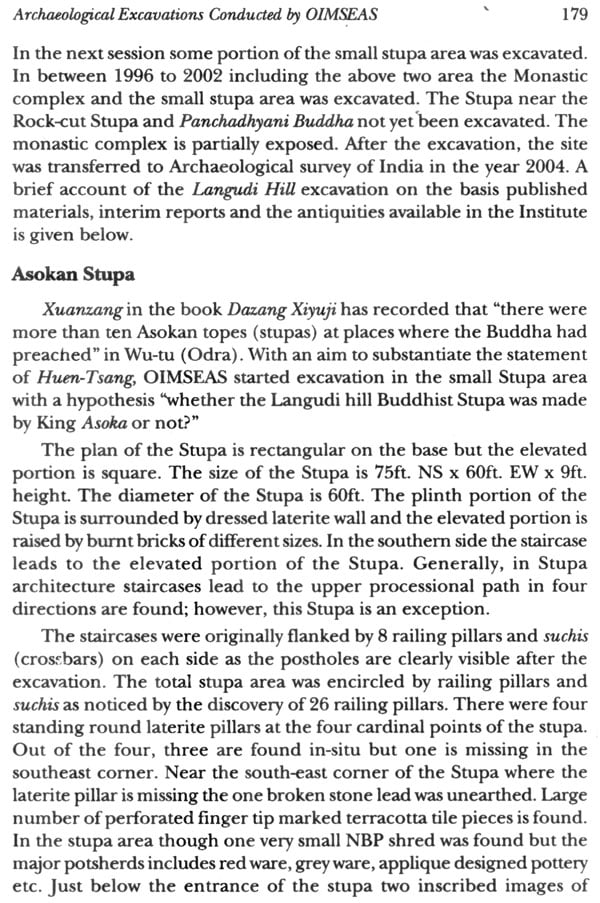
Buddhism and Maritime Heritage of South East Asia (Odishan Perspective)
Book Specification
| Item Code: | NAY666 |
| Author: | Sunil Kumar Patnaik |
| Publisher: | Pratibha Prakashan |
| Language: | English |
| Edition: | 2014 |
| ISBN: | 9788177023411 |
| Pages: | 238 (Throughout Color Illustrations) |
| Cover: | HARDCOVER |
| Other Details | 10.00 X 7.50 inch |
| Weight | 760 gm |
Book Description
In this volume eminent Indian and foreign scholars and researcher have contributed on various aspects of Buddhist heritage and Maritime studies of Southeast Asia with particular focus on Odishan early history such as Buddhism and seafaring activities, deities, fairs and festivals, customs, traditions and legends associated with seafaring activity. Various traditional boats and their manufacturing procedure al 0 have been incorporated in this volume.
The present volume is an attempt to retrieve the methods and resource to facilitate further research and investigation in the field of Buddhist studies and Maritime heritage as also the Early Historical archaeology of South-east Asia.
He has participated in various Archaeological excavations in India and conducted Archaeological excavations at Kankia-Radhanagar (20ID-2013). His field of research includes archaeology, art history, early history and heritage tourism.
He has presented research papers in several international and national Conferences and Seminars and visited countries like Malaysia, Thailand, Sri Lanka and Russia.
He has been working in the field of Tourism, Culture and Archaeology for more than two decades. At present, he is working as an archaeologist in Odisha State Archaeology and holds the position of Secretary, Odishan Institute of Maritime & South East Asian Studies, Govt of Odisha, Bhubaneswar. His publications include Buddhist Heritage of Odisha (200012012), Puri-The Devine Destination (2008).
A~ far as maritime history is concerned, being situated on the Bay of Bengal and with a coastline of 480 kms the State had a glorious past.
The prosperity of the State in ancient times is often attributed its overseas trade with many South East Asian countries including the Roman world. Kalidasa in his Raghuvamsadescribed the king of Kalinga as Mahodadhipati (the lord of the sea). Discovery of Roman gold coins. roulette wares, Chinese potteries along with Chinese Celadon ware from several archaeological sites of Odisha such as Sisupalgarh, Jaugarh, Manikapatna, Khalkattapatna, Palur, etc., amply justify the overseas trade of Odisha. Sculptural panel showing boats carrying elephants, the representation of a giraffe in a sculpture panel at Konark along with the tradition of ceremonial sailing of the boats by the Odias on the day of Kartikapumima, Khudurukuni Osha and Taapoi story indubitably speak of the rich overseas trade in the Indian Ocean and its contacts with the South East Asian countries.
I cake this opportunity to congratulate the Odishan Institute of Maritime and South East Asian Studies (OIMSEAS) and all the Endeavour of all the contributors for bringing out the present anthology on Buddhist Studies, Maritime Heritage and Early History of Odisha.
The ten essays on the subject like Maritime Heritage (KK Basa), Buddhism and Maritime Heritage (S.K Patnaik). Palur - through the Ages G. K Patnaik), Boat Building Tradition (B. Treaty.), Maritime Archaeology (S.Tripati), Navigation and Maritime Goddess of Odisha (T. E. Donaldson), Kalinga and Srilanka (A. Manatunga), Tapassu and Bhallika (M. W. Thero), Maritime Activities of Odisha (B.Patra), Early Historical Cultures of Mahanadi Delta (G. C. Pradhan) together with brief excavation reports of Manikapatna, Langudi, Tarapur, Kayama, Vajragiri, Kankia-Radhanagar etc. Which have been incorporated in the monograph will certainly give a new dimension to Odishan studies and boost further research and publications on the subject in future.
The Archaeological excavations carried out by the ASI and OIMSEAS in the last decades have brought out ancient Buddhist settlements which are significantly laid bare relics and monuments like Stupas, Chaityas, Monasteries and a cache of Buddhist images. The seals and sealings discovered contain many new names like Chandraditya Mahavihara, Madhavpura Mahvihara, Singhaprastha Mahuihara., Devaya Uttara, Sadabhu Tissa and some of the inscriptions refer names like BhekkuTapussadanam, Kaligaraja, (Olivelle, Leoshko, Ray 2012: 85) Purugadiya, Gugolaraba; Sri Sri Buddha which all dates to the early historical period. Besides, the number of pottery remains which help us to date the early historical period of a particular site and region also found from the recent excavations. The pottery specimens like Black and Red ware, NBP, Roulette ware, Knobbed ware, Red Slipped ware etc. are collected from the stratified cultural context from various excavated sites which indicates the cultural interaction and expansion of ancient Odisha. These are now become archaeological resources for historical research of Odishan History and Culture.
It has brought out many unknown and hidden facets of Odishan History; Archaeology, Culture and Art. In fact, the recorded history of Odisha, so far understood, begins with the emergence of major kingdoms in the first phase like Kuru, Kosala, Magadha, Panchala, Surasena, Vasta, Avanti, Videha, Kasi, Anga, Kalinga, Gandhara and Kamboja which all figure in Pusalker's description (Pusalkar 1951 :268- 318). The period of the "Sixteen Mahajanapadas" around the period of Buddha, the knowledge of which is primarily derived from the Buddhist and Jain sources is said to mark the first demonstrably historical phase of ancient Indian political history. The archaeological beginning of early history in the subcontinent covers the period fromc.800 BCE to c.500 BCE (Chakravarti: 2006) coinciding that the Mahajanapada phase which bears a clear literary testimony falls 6th century BCE.
The general scholarly consensus is that the accession of Bimbisara to the throne of Magadha took place in c.544/545 BCE (Raychaudhury 1953:205-9). The dynasty which represented, that is the Hirayanka dynasty, carne to an end around c. 430 BCE. The Magadhan line was then followed by Sisunaga who founded the Sisunaga dynasty. This dynasty came to an end around c. 345 / 365 BCE after which Magadha passed into the control of the Nanda dynasty, the first king Mahpadrnananda. The Puranic sources credit the first king of the Nanda dynasty, Mahapadmananda with victory over large number of kings -Ikshaku, Panchala, Kasi, Haiyhaya, Kalinga, Assmaka, Kuru, Mithila, Surasena and Vitihotra. Thus it suggests that Kalinga on the East coast during this period was the easternmost region under Mahapadmananda. This is also attested to from the Hatigumpha inscription of Kharavela of second/first century BCE about 200-300 years later.
The expansion of Mauryan Empire in 3rd century BCE under the great emperor Asoka, Kalinga remained a powerful kingdom. In the beginning of the third century BCE, it was a fact that the Mauryan king Asoka embraced Buddhism soon after the Kalinga war and left indelible mark in the annals of history of Asia, obviously of Odisha. Inscriptional data provides further corroborations for the presence of Buddhism in the region. In the Buddhist Jataka stories of the fourth and third centuries BCE, a kingdom of Kalinga is mentioned with Dantapura as its capital. So also references have been made in the Vinaya (Mahavagga, First Khanndaka, 4) that the two earliest disciples of Buddha were the merchants Tapussa and Bhallika who hailed from Ukkala· (Utkala) and presented rice, cake. and honey. Structural vestiges of the Mauryan period have recently been unearthed at Langudi and Kankia- Radhanagar. Here, in this work some of the archaeological findings are discussed as part of research work that was under taken by the OIMSEAS.
Book's Contents and Sample Pages


